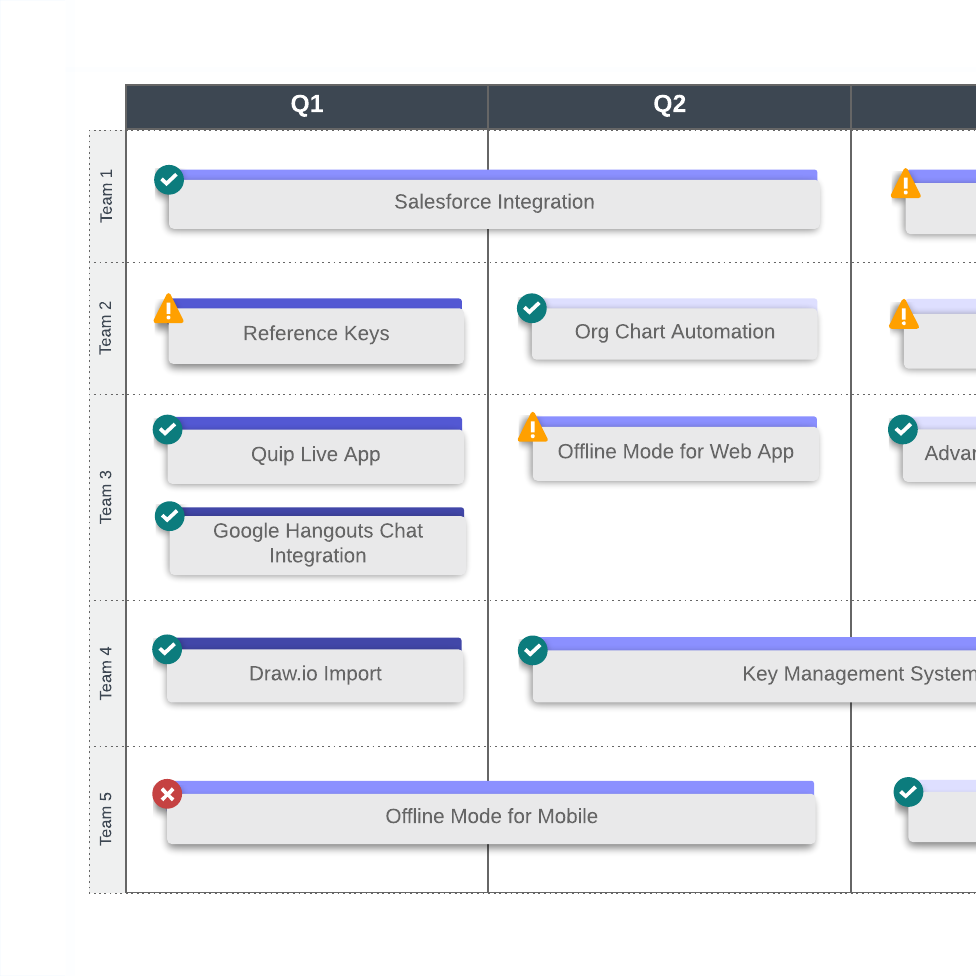
How to release software faster without compromising quality
Lucid Content
Reading time: about 7 min
As businesses continue to move at a rapid pace to keep up with increasing consumer demand, releasing software forces companies to make a difficult choice between quality vs. speed.
Do you choose to get a product out faster but end up having to sacrifice quality? Or do you focus on quality and risk getting beat to market?
It’s a delicate tightrope walk.
The challenge is finding the right balance for your organization. In this article, we’ll cover release management tips to help you stay competitive and deliver higher-quality products faster.
Why you need both speed and quality
In the world of software development, speed is critical. The faster you can deliver products to market, the stronger your competitive edge, and the more opportunity for profit and further innovation.
However, the danger comes when you overvalue speed at the expense of quality.
So what does it mean to deliver quality products? “Quality” is a somewhat vague term that can include metrics like accuracy, efficiency, reliability, function, and excellence. And any time you speed up the release timeline, you risk sacrificing one or more of these values along the way.
In other words, the less time your team has to work out bugs, validate ideas, and test features, the more likely that issues will get lost in the cracks and come up later.
Speed without quality can earn you short-term gains. But in the long run, lower-quality products result in costly time spent fixing bugs you could have prevented, unsatisfied customers, and a damaged brand reputation.
That’s why it’s critical to find a balance between fast delivery and reliable, quality product delivery.
Tips to release software more quickly without sacrificing quality
Fortunately, there are many ways you can shorten delivery timelines while maintaining high-quality standards. Use the following tips and best practices to improve your release management process and deliver better software faster.
Assess your current state
Before you can make improvements to any system or process, it’s important to understand where you’re starting from.
You should assess the current state of your release process to get an accurate picture of what is working well and what opportunities exist for changes and improvements. Work with software developers and other key stakeholders to walk through the process and uncover insights from multiple perspectives.
Pay attention to:
- Testing environments
- Release timelines (and any roadblocks)
- Product backlogs
- Documentation (or lack thereof)
- Automation processes
- Release management roles
- Team morale
All of these can affect your speed and quality. When you understand what your process actually looks like now, you can make strategic decisions and create more effective plans to improve.
Set clear goals and expectations
What are your release goals? What timeline makes sense for your business and what expectations do you have for quality standards? The answers will, of course, depend on your team and company’s individual priorities, resources, and strategy. But when you understand (and outline) your goals and expectations, you can more effectively communicate and create a plan to achieve them.
This is especially important for motivating your development team and getting everyone on the same page. After all, in order to maintain reliable quality standards and consistent delivery, your team needs to know what constraints they’re working within.
Communicate your priorities and expectations clearly to get buy-in from the team. When everyone understands what is expected and is committed to achieving those goals, you are more likely to meet those standards.
Document your release plans
Both speed and quality rely on a streamlined process—which means communication is critical.
Make sure your team has visibility into your release process and clear channels for communication. While no one likes to hear it, documentation is key. Document your release plans and make sure everyone has access to the information and can update and reference those plans as needed.
Clear documentation will help you avoid miscommunication and keep everyone on the same page. Record what you do as well as how you do it. Involve everyone in the process so that documentation is clear, collaborative, and more easily adopted and implemented.
When everyone understands the goals, expectations, and process (and their roles within that system), everything will run more smoothly.

See the ideal process for creating your Agile release plan (complete with a customizable template!).
Learn moreAutomate processes
Automation is one of the simplest but most effective ways to increase speed while maintaining—and often improving—quality.
Automation relieves your team of repetitive manual tasks so they can focus on other key priorities. This saves valuable time and human resources while reducing human error and ensuring more consistent results.
Review your release process to identify good candidates for automation. These might include automated checks for code quality, accessibility, usability, and security as well as automated regression testing.
Invest in continuous delivery
A focus on automation should also include a conversation about continuous delivery. Continuous delivery is a component of the DevOps approach that focuses on getting code into production quickly and sustainably.
One of the primary ways continuous delivery allows organizations to release more often is by automating testing for each new feature, bug fix, or change. Under continuous delivery, code changes are automatically built, tested, and packaged for release. This helps streamline the development process, reduce risks, and ensure a consistent release timeline.
Invest in continuous delivery to optimize and streamline your delivery processes so that you can release more products more quickly and reliably.
Understand QA’s role in software releases
Quality assurance (QA) is an important part of delivering safe, high-quality code every time. But when working under tight deadlines and short sprints in an agile environment, QA can be tricky to prioritize. After all, when running short release iterations, you can’t reasonably test everything every time.
When prioritizing where and what your QA team focuses on in each release, consider these three tips:
-
Prioritize bug fixes based on usage. Areas of the code that get a lot of use and traffic should take higher priority for QA checks.
-
Focus on areas where the most significant changes to the code were made. That way you don’t waste time on areas that are low risk and have been tested in previous iterations. Leave those to your automated checks.
-
Talk to your development team and stakeholders to identify and understand the release criteria so you know what standards need to be met. This will help you focus on verifying those standards so there is no confusion about what was delivered.
Test and retest before releasing
It may sound counterintuitive to repeat testing before release when you’re trying to deliver with velocity. But testing will help you catch any errors or bugs you missed before releasing into production and thus avoid costly fixes and delays down the road.
This is why it is so important to build a strong release management process that includes automation and robust testing standards. Whether that’s through a simple automation process or by implementing a continuous delivery approach, build testing into each stage of development to keep standards high while maintaining speed.
Rely on and trust your team
Your team members are the experts on the ground. As you focus on building and improving your release management process, take advantage of their expertise and insights. Talk to your team to get input on what is working well, what challenges they face, and what they would recommend for improvement. Implement their feedback and communicate along the way to ensure clarity and increase buy-in and support for new processes.
Once the changes are implemented, trust your team to get the job done. Facilitate communication and collaboration and make sure they have the knowledge and resources to succeed.
When you trust your team and give them the tools they need, the development will go smoother, and the quality and speed of delivery will improve.
When it comes to software development, speed and quality will always be in a tug of war. But with the right tools and processes in place, you can create an environment that delivers better products quickly and reliably every time.

Now see how Lucidchart can help you release software quickly. Build product roadmaps, technical documentation, and more.
Read moreAbout Lucidchart
Lucidchart, a cloud-based intelligent diagramming application, is a core component of Lucid Software's Visual Collaboration Suite. This intuitive, cloud-based solution empowers teams to collaborate in real-time to build flowcharts, mockups, UML diagrams, customer journey maps, and more. Lucidchart propels teams forward to build the future faster. Lucid is proud to serve top businesses around the world, including customers such as Google, GE, and NBC Universal, and 99% of the Fortune 500. Lucid partners with industry leaders, including Google, Atlassian, and Microsoft. Since its founding, Lucid has received numerous awards for its products, business, and workplace culture. For more information, visit lucidchart.com.
